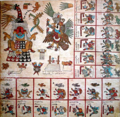
Trecena
Encyclopedia

Pre-Columbian
The pre-Columbian era incorporates all period subdivisions in the history and prehistory of the Americas before the appearance of significant European influences on the American continents, spanning the time of the original settlement in the Upper Paleolithic period to European colonization during...
Mesoamerican calendars
Mesoamerican calendars
Mesoamerican calendars are the calendrical systems devised and used by the pre-Columbian cultures of Mesoamerica. In addition to the basic function of a calendar—defining and organizing periods of time in a way that allows events to be fixed, ordered and noted relative to each other and some...
. The 260-day calendar
Calendar
A calendar is a system of organizing days for social, religious, commercial, or administrative purposes. This is done by giving names to periods of time, typically days, weeks, months, and years. The name given to each day is known as a date. Periods in a calendar are usually, though not...
(the tonalpohualli
Tonalpohualli
The tonalpohualli, a Nahuatl word meaning "count of days", is a 260-day sacred period in use in pre-Columbian Mesoamerica, especially among the Aztecs. This calendrical period is neither solar nor lunar, but rather consists of 20 trecena, or 13-day periods...
) was divided into 20 trecenas. Trecena is derived from the Spanish chroniclers and translates to 'a group of thirteen' in the same way that a dozen (or in Spanish docena) relates to the number twelve. It is associated with the Aztec
Aztec
The Aztec people were certain ethnic groups of central Mexico, particularly those groups who spoke the Nahuatl language and who dominated large parts of Mesoamerica in the 14th, 15th and 16th centuries, a period referred to as the late post-classic period in Mesoamerican chronology.Aztec is the...
s, but is called different names in the calendar
Calendar
A calendar is a system of organizing days for social, religious, commercial, or administrative purposes. This is done by giving names to periods of time, typically days, weeks, months, and years. The name given to each day is known as a date. Periods in a calendar are usually, though not...
s of the Maya
Maya civilization
The Maya is a Mesoamerican civilization, noted for the only known fully developed written language of the pre-Columbian Americas, as well as for its art, architecture, and mathematical and astronomical systems. Initially established during the Pre-Classic period The Maya is a Mesoamerican...
, Zapotec
Zapotec civilization
The Zapotec civilization was an indigenous pre-Columbian civilization that flourished in the Valley of Oaxaca of southern Mesoamerica. Archaeological evidence shows their culture goes back at least 2500 years...
, Mixtec
Mixtec
The Mixtec are indigenous Mesoamerican peoples inhabiting the Mexican states of Oaxaca, Guerrero and Puebla in a region known as La Mixteca. The Mixtecan languages form an important branch of the Otomanguean language family....
, and others of the region.
Many surviving Mesoamerican codices, such as Codex Borbonicus
Codex Borbonicus
The Codex Borbonicus is an Aztec codex written by Aztec priests shortly before or after the Spanish conquest of Mexico. The codex is named after the Palais Bourbon in France. It is held at the Bibliothèque de l'Assemblée Nationale in Paris...
, are divinitory calendars, based on the 260-day year, with each page representing one trecena.

